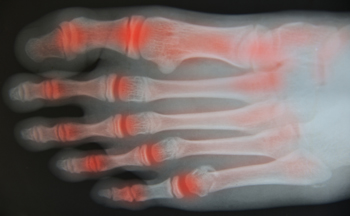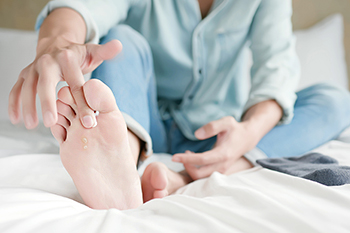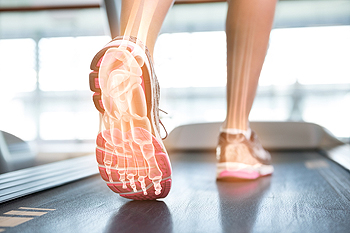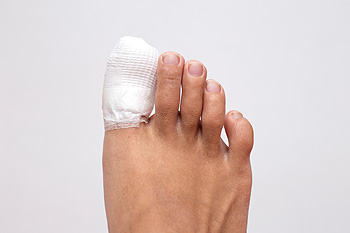Garner (919) 661-4150
June 2022
Ankle Arthritis Can Cause Severe Pain

Arthritis in the feet can be a debilitating condition and it may occur from a prior injury to the ankle, obesity, or joint infection. Additionally, rheumatoid disease may lead to ankle arthritis and this may be a result of inflammation of the joint cartilage. Research has shown there are three stages of ankle arthritis. Many patients tend to ignore symptoms in the first stage and will gradually feel the pain while moving the ankle. It is often possible to perform specific exercises during this stage, and this may help to alleviate some of the discomforts. It becomes increasingly difficult to ignore the symptoms during stage two and severe pain and discomfort can occur while walking or running. During stage three, the cartilage is almost completely gone and there is often friction between the bones due to reduced lubricating fluids. There are several treatment options for ankle arthritis including arch supports for the feet, controlling body weight to help reduce pressure on the ankle joints, and performing ankle exercises. If you have ankle pain and think it may be arthritis, it is suggested to consult with a podiatrist who can effectively treat this condition.
Arthritis can be a difficult condition to live with. If you are seeking treatment, contact Chukwuma Ukata, DPM from Advanced Carolina Foot and Ankle Center. Our doctor can provide the care you need to keep you pain-free and on your feet.
Arthritic Foot Care
Arthritis is a term that is commonly used to describe joint pain. The condition itself can occur to anyone of any age, race, or gender, and there are over 100 types of it. Nevertheless, arthritis is more commonly found in women compared to men, and it is also more prevalent in those who are overweight. The causes of arthritis vary depending on which type of arthritis you have. Osteoarthritis for example, is often caused by injury, while rheumatoid arthritis is caused by a misdirected immune system.
Symptoms
- Swelling
- Pain
- Stiffness
- Decreased Range of Motion
Arthritic symptoms range in severity, and they may come and go. Some symptoms stay the same for several years but could potentially get worse with time. Severe cases of arthritis can prevent its sufferers from performing daily activities and make walking difficult.
Risk Factors
- Occupation – Occupations requiring repetitive knee movements have been linked to osteoarthritis
- Obesity – Excess weight can contribute to osteoarthritis development
- Infection – Microbial agents can infect the joints and trigger arthritis
- Joint Injuries – Damage to joints may lead to osteoarthritis
- Age – Risk increases with age
- Gender –Most types are more common in women
- Genetics – Arthritis can be hereditary
If you suspect your arthritis is affecting your feet, it is crucial that you see a podiatrist immediately. Your doctor will be able to address your specific case and help you decide which treatment method is best for you.
If you have any questions, please feel free to contact our office located in Garner, NC . We offer the newest diagnostic and treatment technologies for all your foot care needs.
Wounds That Don't Heal Need to Be Checked
Scratching the Surface on Possible Causes of Itchy Feet

While you may assume that athlete’s foot is the cause of your itchy feet, there are other possible culprits. Two other infections that can make your feet itchy are scabies, which also causes an itchy rash, and hookworm. Skin disorders, such as dyshidrotic eczema, a form of eczema that affects the feet, or psoriasis may also be to blame. Or you may be having an allergic reaction to a substance your feet have come in contact with. Peripheral or diabetic neuropathy injures nerve fibers which can then cause uncomfortable sensations in the feet, such as itchiness, pain, and numbness. Itchiness can also be a lingering after-effect of a burn on the skin of your feet. With so many possible causes of itchy feet, it makes sense to get the professional opinion of a podiatrist who can diagnose and treat your condition properly.
Athlete’s Foot
Athlete’s foot is often an uncomfortable condition to experience. Thankfully, podiatrists specialize in treating athlete’s foot and offer the best treatment options. If you have any questions about athlete’s foot, consult with Chukwuma Ukata, DPM from Advanced Carolina Foot and Ankle Center. Our doctor will assess your condition and provide you with quality treatment.
What Is Athlete’s Foot?
Tinea pedis, more commonly known as athlete’s foot, is a non-serious and common fungal infection of the foot. Athlete’s foot is contagious and can be contracted by touching someone who has it or infected surfaces. The most common places contaminated by it are public showers, locker rooms, and swimming pools. Once contracted, it grows on feet that are left inside moist, dark, and warm shoes and socks.
Prevention
The most effective ways to prevent athlete’s foot include:
- Thoroughly washing and drying feet
- Avoid going barefoot in locker rooms and public showers
- Using shower shoes in public showers
- Wearing socks that allow the feet to breathe
- Changing socks and shoes frequently if you sweat a lot
Symptoms
Athlete’s foot initially occurs as a rash between the toes. However, if left undiagnosed, it can spread to the sides and bottom of the feet, toenails, and if touched by hand, the hands themselves. Symptoms include:
- Redness
- Burning
- Itching
- Scaly and peeling skin
Diagnosis and Treatment
Diagnosis is quick and easy. Skin samples will be taken and either viewed under a microscope or sent to a lab for testing. Sometimes, a podiatrist can diagnose it based on simply looking at it. Once confirmed, treatment options include oral and topical antifungal medications.
If you have any questions, please feel free to contact our office located in Garner, NC . We offer the newest diagnostic and treatment technologies for all your foot care needs.
Common Foot Problems

We use our feet for most of what we do in life and given that each foot is made up of 26 bones, developing various foot problems over our lifetimes is not surprising. One’s feet can get injured, inflamed, or malfunction in a multitude of ways. Wearing improper footwear, having a chronic disease like diabetes, and aging are the major contributors to foot problems. The most common symptom of foot problems is pain—in the ankles, toes, heels, or soles of the feet. Some conditions causing foot pain are discussed here. Athlete’s foot is a contagious fungal infection resulting in itchy, stinging, and burning feet and toes. A bunion is a bump on the side of the big toe causing the toe to bend inward towards the other toes. Corns are round circles of thickened skin on toes or soles of feet that develop to prevent blisters. Plantar Fasciitis is when the plantar fascia ligament running along the bottom of the foot becomes strained or sustains micro tears. Heel spurs are bony protrusions that grow from calcium deposits between the heel and arch of the foot and appear on the front of the heel. Hammertoes are when toes curve down rather than out. An ingrown toenail is when a toenail grows into the surrounding skin. A plantar wart is a wart on the bottom of the foot that arises from the human papillomavirus. Flat foot is when the arch of the foot collapses. Diabetic neuropathy is when there is damage to the nerves of the feet due to unregulated high blood sugar and one experiences a tingling feeling or loss of feeling in the foot. If you suffer from pain in any part of your foot, consult with a podiatrist for proper diagnosis and a customized treatment plan.
If you have any concerns about your feet, contact Chukwuma Ukata, DPM from Advanced Carolina Foot and Ankle Center. Our doctor can provide the care you need to keep you pain-free and on your feet.
Biomechanics in Podiatry
Podiatric biomechanics is a particular sector of specialty podiatry with licensed practitioners who are trained to diagnose and treat conditions affecting the foot, ankle and lower leg. Biomechanics deals with the forces that act against the body, causing an interference with the biological structures. It focuses on the movement of the ankle, the foot and the forces that interact with them.
A History of Biomechanics
- Biomechanics dates back to the BC era in Egypt where evidence of professional foot care has been recorded.
- In 1974, biomechanics gained a higher profile from the studies of Merton Root, who claimed that by changing or controlling the forces between the ankle and the foot, corrections or conditions could be implemented to gain strength and coordination in the area.
Modern technological improvements are based on past theories and therapeutic processes that provide a better understanding of podiatric concepts for biomechanics. Computers can provide accurate information about the forces and patterns of the feet and lower legs.
Understanding biomechanics of the feet can help improve and eliminate pain, stopping further stress to the foot.
If you have any questions please feel free to contact our office located in Garner, NC . We offer the newest diagnostic and treatment technologies for all your foot and ankle needs.
Buddy Taping May Be a Possible Treatment Method

When patients incur a broken toe, their lives may change temporarily. It may be difficult to walk, and completing daily activities can be challenging. The common symptoms that many people experience with a broken toe can include extreme pain and tenderness, bruising, and swelling. Severe breaks will often display a bone that protrudes through the skin. A broken toe is often the result of a heavy object dropping on it, or being stubbed against a piece of furniture. Relief may come from resting the affected toe, and taping it to the toe next to it. This is referred to as buddy taping, and can be a successful method in providing the stability that is needed as the healing process occurs. Many broken toes are diagnosed by having X-rays taken, and this is helpful in determining the severity of the fracture. A boot or cast may be prescribed for severe breaks, and this can help to alleviate pressure that is put on the toe. If you have broken your toe, it is advised that you seek the counsel of a podiatrist who can help you to treat your it properly.
A broken toe can be very painful and lead to complications if not properly fixed. If you have any concerns about your feet, contact Chukwuma Ukata, DPM from Advanced Carolina Foot and Ankle Center. Our doctor will treat your foot and ankle needs.
What to Know About a Broken Toe
Although most people try to avoid foot trauma such as banging, stubbing, or dropping heavy objects on their feet, the unfortunate fact is that it is a common occurrence. Given the fact that toes are positioned in front of the feet, they typically sustain the brunt of such trauma. When trauma occurs to a toe, the result can be a painful break (fracture).
Symptoms of a Broken Toe
- Throbbing pain
- Swelling
- Bruising on the skin and toenail
- The inability to move the toe
- Toe appears crooked or disfigured
- Tingling or numbness in the toe
Generally, it is best to stay off of the injured toe with the affected foot elevated.
Severe toe fractures may be treated with a splint, cast, and in some cases, minor surgery. Due to its position and the pressure it endures with daily activity, future complications can occur if the big toe is not properly treated.
If you have any questions please feel free to contact our office located in Garner, NC . We offer the newest diagnostic and treatment technologies for all your foot and ankle needs.







